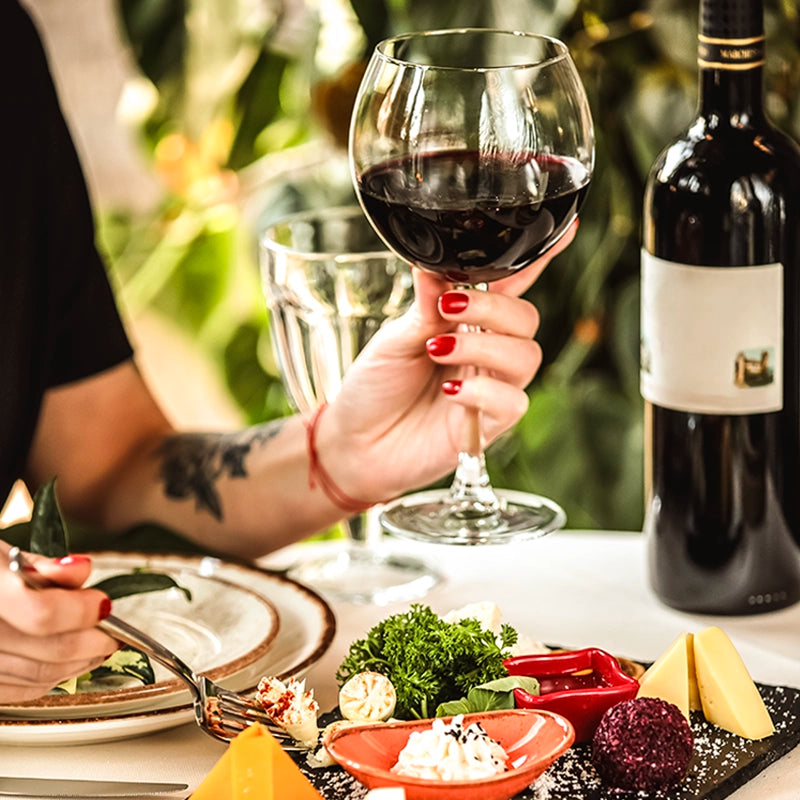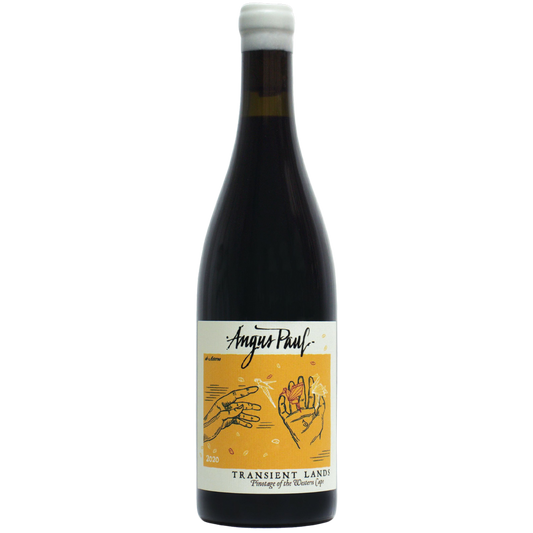the ultimate red wine guide: mastering pairing, storing and serving
Red wine, a timeless beverage steeped in history and bursting with flavour, is more than just a drink. But where do you begin when faced with a seemingly endless array of bottles? Fear not, fellow wine explorer! We're here to guide you through the wonderful world of red, from the basics to the bold.

HOW IS red WINE MADE?
It all starts with the grapes, carefully picked at peak ripeness.
The juicy grapes are gently de-stemmed and crushed, releasing their vibrant pulp and precious juice.
Skins infuse the juice with colour, tannins, and flavour compounds.
The skins are gently pressed, separating the precious liquid gold – the young wine.
Fermentation is the heart and soul of red winemaking. The yeast transform sugars into alcohol and release carbon dioxide.
During the malolactic fermentation, another set of bacteria converts harsh malic acid (think green apple) into softer lactic acid (think creamy yogurt). This adds smoothness and complexity to the wine.
Some red wines spend time maturing in oak barrels to add complexity, structure, and ageability to the final product. New barrels impart more intense oak character, while used barrels offer softer, more subtle influences. Young, fruit-forward reds might see minimal barrel time, while powerful wines like Barolo can slumber for years.
Famous red wine regions of the world
food pairing

Salads
Light-bodied reds: Think Pinot Noir or Gamay. Opt for salads with berries, goat cheese, or grilled chicken for a harmonious match.
Medium-bodied reds: Sangiovese or Merlot can work well with salads containing heavier dressings, roasted vegetables, or grilled meats.
Sauces
Tomato-based sauces: Sangiovese's acidity cuts through the richness, making it ideal for pasta with marinara or pizza.
Creamy sauces: Consider lighter-bodied reds like Pinot Noir or Gamay to avoid clashing with the creaminess.
Spicy sauces: Embrace bold reds like Zinfandel or Syrah to stand up to the heat and complement spices like chipotle or black pepper.
Beef
Grilled steak: Cabernet Sauvignon's boldness pairs well with grilled steak, especially with chimichurri or peppercorn sauces.
Beef stew: Merlot's smooth tannins and dark fruit notes complement the richness of stews like bourguignon.
Ground beef: Sangiovese or Barbera add acidity and cut through the richness of burgers or pasta Bolognese.
Chicken
Roasted chicken: Pinot Noir's delicate fruitiness complements the flavors of roasted chicken, especially with herbs like rosemary or thyme.
Grilled chicken: Gamay's light body and acidity pair well with grilled chicken with lighter sauces or marinades.
Chicken piccata: Choose a medium-bodied red like Barbera or Chianti for its acidity to balance the lemon sauce and capers.
Seafood
Salmon: Pinot Noir's delicate fruitiness enhances the flavors of grilled or roasted salmon, especially with creamy sauces.
Tuna: Grenache or Syrah's peppery notes complement the richness of grilled or seared tuna steaks.
Shellfish: Consider lighter-bodied reds like Pinot Noir or Gamay for mussels, clams, or shrimp scampi.
Fish
White fish: Opt for light-bodied reds like Pinot Noir or Gamay for delicate whitefish like cod or sole.
Swordfish: Look to medium-bodied reds like Sangiovese or Merlot for their acidity to balance the richer flavour of swordfish.
Salmon: Pinot Noir remains a versatile choice for salmon, regardless of cooking method.
Cheese
Bold wines for bold cheeses: Powerful Cabernet Sauvignons and Malbecs crave equally bold flavours like aged cheddar, Gouda, or Manchego.
Medium-bodied reds for medium cheeses: Sangiovese, Merlot, and Pinot Noir shine with semi-firm cheeses like Gruyere, Emmental, or Comté.
Light-bodied reds for delicate cheeses: Gamay and Beaujolais complement milder cheeses like brie, chèvre, or mozzarella.
Don't be afraid to go beyond the classics! Some unique pairings to try:
Pecorino Romano with Chianti: The salty, sheep's milk cheese perfectly complements Chianti's acidity and herbal notes.
Brie with Pinot Noir: The creaminess of brie balances the delicate fruitiness of Pinot Noir, making for a smooth and luxurious pairing.
red wine cheat sheet
how to store
-

Temperature
Coolness is key. Aim for a consistent temperature between 10-13°C. Avoid extremes and fluctuations.
-

Light
Darkness is your friend. Light can damage wine. Store bottles in a dark place, like a cellar or wine fridge.
-

Position
Keep it horizontal. Lying down keeps the cork moist, preventing it from drying out and letting air in.
-

Vibration
Vibration is the enemy. Constant movement can stress the wine. Opt for a stable storage location. Avoid storing near appliances or high traffic areas.
how to serve
-
Light-bodied reds
E.g., Pinot Noir and Gamay: these wines shine slightly chilled, around 13 to 15°C.
-
Medium-bodied reds
E.g., Merlot, Sangiovese, and Rioja: aim for a comfortable cellar temperature, around 15 to 18°C.
-
Full-bodied reds
E.g., Cabernet Sauvignon, Malbec, and Zinfandel: these wines love a bit more warmth. Shoot for 18 to 21°C.
decanting
-
Decanting isn't mandatory, but it can enhance your red wine experience.
Decanting isn't just for fancy occasions. It allows the wine to
"breathe," softening tannins and releasing aromas. -
Young, fruit-forward wines: These generally don't require decanting.
Full-bodied, age-worthy reds: These benefit greatly from decanting. Pour gently into a decanter 30-60 minutes before serving. -
Sediment?
No worries: It's natural in aged wines. Tilt the bottle and pour slowly, leaving the sediment behind.
spotlight on pinotage


Pinotage Fine Wine
Pinotage is a uniquely South African grape that marries the fruitiness of...





